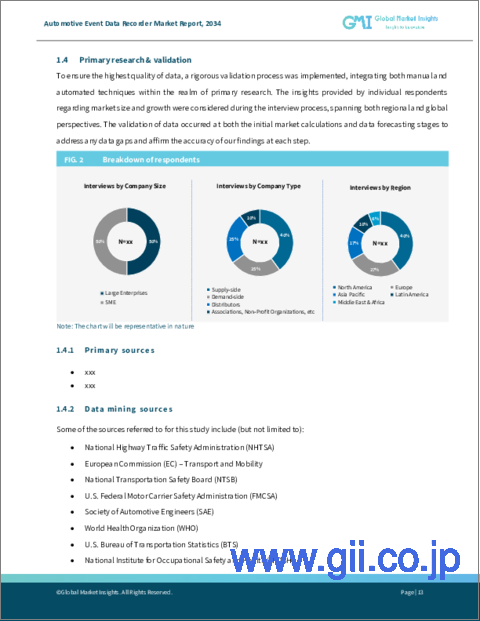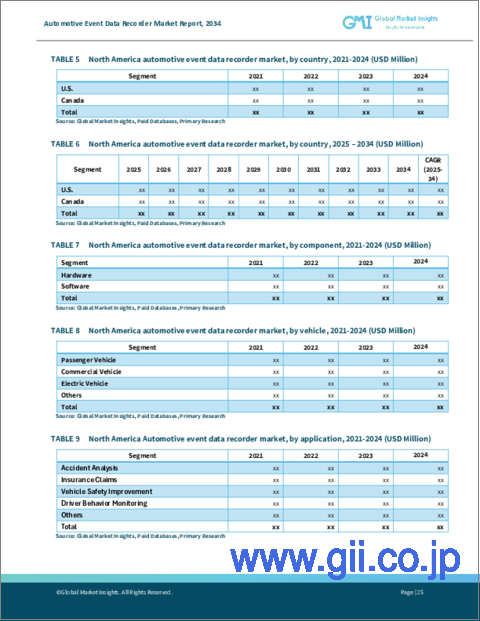|
|
市場調査レポート
商品コード
1572433
自動車用イベントデータレコーダ市場、機会、成長促進要因、産業動向分析と予測、2024年~2032年Automotive Event Data Recorder Market, Opportunity, Growth Drivers, Industry Trend Analysis and Forecast, 2024-2032 |
||||||
カスタマイズ可能
|
|||||||
| 自動車用イベントデータレコーダ市場、機会、成長促進要因、産業動向分析と予測、2024年~2032年 |
|
出版日: 2024年08月16日
発行: Global Market Insights Inc.
ページ情報: 英文 250 Pages
納期: 2~3営業日
|
- 全表示
- 概要
- 目次
自動車用イベントデータレコーダの世界市場規模は、2023年に18億米ドルとなり、2024年から2032年にかけてCAGR 6%以上で成長すると予測されています。
自動車安全規制の強化が市場拡大の主な要因です。各国政府は厳しい安全基準を施行し、事故時に重要なデータを取得するイベント・データ・レコーダー(EDR)の車両への搭載を義務付けています。このような規制は車両の安全性を強化し、速度やブレーキパターンなどの重要な情報が衝突後の分析に利用できるようにします。
例えば、欧州連合(EU)の一般安全規則(General Safety Regulation)は、交通安全の強化と事故調査の合理化を目的として、新車にEDRの搭載を義務付けています。米国では、国家道路交通安全局(NHTSA)が安全性と衝突評価に関連するデータを収集するため、EDRに関する規則を導入しています。規制の強化に伴い、EDRの需要が急増しており、市場の成長を後押しする構えです。
自動車EDR分野の顕著な動向は、これらのシステムとADAS(先進運転支援システム)との融合です。自動車が自動ブレーキや車線維持支援のようなADAS技術を採用するにつれて、EDRはこれらの技術革新からデータを取得するように適応しています。この相乗効果によって事故分析がより豊かになり、速度などの従来の指標だけでなく、ADASの介入に関する洞察も可能になります。例えば、自動ブレーキシステムが衝突前に作動した場合、EDRの洞察によって衝突調査を改善し、車両の安全機能を強化することができます。
世界の自動車用イベントデータレコーダ産業は、コンポーネント、車両、用途、地域に基づいて分類されます。
市場はコンポーネント別に、ハードウェアとソフトウェアに区分されます。2023年の市場シェアは、ハードウェアが72%を占めています。この優位性は、重要な事故データの取得と保存においてハードウェアが極めて重要な役割を果たすことに起因しています。EDRのハードウェアは、センサーから記録装置まで幅広く、車両の性能を監視し、速度やブレーキなどの指標を記録します。これらのハードウェア・コンポーネントの精度は、効果的な事故分析に不可欠です。さらに、ストレージの強化やシステム統合などの技術的進歩は、データ取得と安全機能を洗練させることで市場の成長をさらに後押ししています。
市場は、乗用車、商用車、電気自動車、その他の車両に分類されます。2023年の市場シェアは乗用車が53%でトップです。このリーダーシップは、乗用車の台数の多さと安全機能の厳格な義務化に起因しています。安全基準が強化されるにつれて、乗用車におけるEDRの需要も増加し、コンプライアンスが確保され、事故分析が強化されます。さらに、乗用車は商用車や電気自動車に比べて先進安全技術の採用が早いため、このセグメントの優位性が強化されています。個人所有の自動車でEDRが広く使用されていることは、衝突調査を助けるだけでなく、全体的な自動車の安全性を高めています。
アジア太平洋の自動車用イベントデータレコーダ産業は、2023年に29%のシェアを獲得しました。この成長の原動力となっているのは、自動車生産の急増と安全意識の高まりです。中国や日本のような国は安全基準を強化しており、EDRの採用をさらに促進しています。急成長する自動車部門と地域の技術進歩が相まって、EDRシステムを含む先進安全機能に対する需要が顕著になっています。北米は、厳格な安全規制と先進自動車技術の迅速な導入により、もう一つの主要市場となっています。米国とカナダは、包括的な自動車安全基準を制定しており、重要な事故データを取得するためのEDRの必要性を強調しています。
目次
第1章 調査手法と調査範囲
第2章 エグゼクティブサマリー
第3章 業界洞察
- エコシステム分析
- サプライヤーの状況
- EDRハードウェアプロバイダー
- EDRソフトウェアプロバイダー
- ディストリビューター/ロジスティクス
- エンドユーザー
- 利益率分析
- 技術とイノベーションの展望
- 特許分析
- 主要ニュースとイニシアチブ
- 規制状況
- 影響要因
- 促進要因
- 自動車安全規制の強化
- 交通安全意識の高まり
- データ分析とコネクティビティの進歩
- ADAS(先進運転支援システム)の需要拡大
- 業界の潜在的リスク&課題
- データのプライバシーとセキュリティに関する懸念
- 既存の車両システムとの統合
- 促進要因
- 成長可能性分析
- ポーター分析
- PESTEL分析
第4章 競合情勢
- イントロダクション
- 各社の市場シェア
- 主要市場プレーヤーの競合分析
- 競合のポジショニング・マトリックス
- 戦略展望マトリックス
第5章 市場推計・予測:コンポーネント別、2021年~2032年
- 主要動向
- ハードウェア
- イベントデータレコーダーユニット
- センサー
- 加速度計
- ジャイロスコープ
- スピードセンサー
- ブレーキセンサー
- エアバッグ展開センサー
- ストレージデバイス
- 電源ユニット
- ソフトウェア
- データ解析ソフトウェア
- データ検索ソフトウェア
- クラウドベースのプラットフォーム
第6章 市場推計・予測:車両別、2021年~2032年
- 主要動向
- 乗用車
- 商用車
- 電気自動車
- その他
第7章 市場推計・予測:用途別、2021年~2032年
- 主要動向
- 事故分析
- 保険請求
- 自動車の安全性向上
- 促進要因行動モニタリング
- その他
第8章 市場推計・予測:販売チャネル別、2021年~2032年
- 主要動向
- OEM
- アフターマーケット
第9章 市場推計・予測:地域別、2021-2032年
- 主要動向:地域別
- 北米
- 米国
- カナダ
- 欧州
- 英国
- ドイツ
- フランス
- イタリア
- スペイン
- ロシア
- 北欧
- その他欧州
- アジア太平洋
- 中国
- インド
- 日本
- 韓国
- ニュージーランド
- 東南アジア
- その他アジア太平洋地域
- ラテンアメリカ
- ブラジル
- メキシコ
- アルゼンチン
- その他ラテンアメリカ
- 中東・アフリカ
- 南アフリカ
- サウジアラビア
- アラブ首長国連邦
- その他中東・アフリカ
第10章 企業プロファイル
- Aptiv PLC
- Autoliv Inc.
- Continental AG
- Delphi Technologies PLC
- DENSO Corporation
- Harman International Industries, Incorporated
- Hitachi Automotive Systems, Ltd.
- Hyundai Mobis Co., Ltd.
- Infineon Technologies AG
- Magna International Inc.
- Mitsubishi Electric Corporation
- Murata Manufacturing Co., Ltd.
- NXP Semiconductors N.V.
- Panasonic Automotive Systems Company of America
- Robert Bosch GmbH
- Robertshaw Controls Company
- TRW Automotive Holdings Corp.
- Valeo SA
- VDO Automotive AG
- ZF Friedrichshafen AG
The Global Automotive Event Data Recorder Market was valued at USD 1.8 billion in 2023 and is projected to grow at a CAGR of over 6% from 2024 to 2032. The surge in mandatory vehicle safety regulations is a primary catalyst for this market's expansion. Governments globally are enforcing stringent safety standards, mandating vehicles to be fitted with event data recorders (EDRs) to capture vital data during accidents. Such regulations bolster vehicle safety, ensuring essential information-like speed and braking patterns-is accessible for post-collision analysis.
For example, the European Union's General Safety Regulation requires new cars to have EDRs, aiming to bolster road safety and streamline accident investigations. In the U.S., the National Highway Traffic Safety Administration (NHTSA) has introduced rules for EDRs to gather data pertinent to safety and crash evaluations. With regulations tightening, the surging demand for EDRs is poised to propel market growth.
A notable trend in the automotive EDR sector is the melding of these systems with advanced driver assistance systems (ADAS). As vehicles adopt ADAS technologies-like automatic braking and lane-keeping assist-EDRs are adapting to capture data from these innovations. This synergy enriches accident analysis, allowing insights not just on conventional metrics like speed but also on ADAS interventions. For instance, should an automatic braking system engage pre-collision, the EDR's insights can refine crash investigations and bolster vehicle safety features.
The global automotive event data recorder industry is classified based on component, vehicle, application, and region.
The market, segmented by components, divides into hardware and software. In 2023, hardware dominated with a 72% market share. This supremacy stems from hardware's pivotal role in capturing and archiving crucial accident data. EDR hardware-spanning sensors to recording devices-monitors vehicle performance, logging metrics like speed and braking. The precision of these hardware components is vital for effective accident analysis. Moreover, technological strides-like enhanced storage and system integration-further fuel market growth by refining data capture and safety features.
Segmented by vehicle type, the market includes passenger, commercial, electric, and other vehicles. In 2023, passenger vehicles led with a 53% market share. This leadership is attributed to the sheer volume of passenger vehicles and stringent safety feature mandates. As safety standards intensify, so does the demand for EDRs in passenger vehicles, ensuring compliance and bolstering accident analysis. Furthermore, passenger cars' quicker adoption of advanced safety technologies, compared to their commercial and electric counterparts, reinforces this segment's dominance. The prevalent use of EDRs in personal vehicles not only aids crash investigations but also elevates overall vehicle safety.
Asia Pacific Automotive Event Data Recorder Industry commanded a significant 29% share in 2023. This growth is fueled by surging vehicle production and heightened safety consciousness. Nations like China and Japan are tightening safety standards, further propelling EDR adoption. Coupled with a burgeoning automotive sector and regional technological strides, there's a pronounced demand for advanced safety features, EDR systems included. North America, with its rigorous safety regulations and swift adoption of advanced vehicle technologies, stands as another key market. Both the U.S. and Canada have instituted comprehensive vehicle safety standards, underscoring the necessity of EDRs for critical accident data capture.
Table of Contents
Chapter 1 Methodology and Scope
- 1.1 Research design
- 1.1.1 Research approach
- 1.1.2 Data collection methods
- 1.2 Base estimates and calculations
- 1.2.1 Base year calculation
- 1.2.2 Key trends for market estimation
- 1.3 Forecast model
- 1.4 Primary research and validation
- 1.4.1 Primary sources
- 1.4.2 Data mining sources
- 1.5 Market definitions
Chapter 2 Executive Summary
- 2.1 Industry 360° synopsis, 2021 - 2032
Chapter 3 Industry Insights
- 3.1 Industry ecosystem analysis
- 3.2 Supplier landscape
- 3.2.1 EDR Hardware Providers
- 3.2.2 EDR Software Providers
- 3.2.3 Distributors/ Logistics
- 3.2.4 End user
- 3.3 Profit margin analysis
- 3.4 Technology and innovation landscape
- 3.5 Patent analysis
- 3.6 Key news and initiatives
- 3.7 Regulatory landscape
- 3.8 Impact forces
- 3.8.1 Growth drivers
- 3.8.1.1 Increasing Mandatory Vehicle Safety Regulations
- 3.8.1.2 Rising Road Safety Awareness
- 3.8.1.3 Advancements in Data Analytics and Connectivity
- 3.8.1.4 Growing Demand for Advanced Driver Assistance Systems (ADAS)
- 3.8.2 Industry pitfalls and challenges
- 3.8.2.1 Data privacy and security concerns
- 3.8.2.2 Integration with existing vehicle systems
- 3.8.1 Growth drivers
- 3.9 Growth potential analysis
- 3.10 Porter's analysis
- 3.11 PESTEL analysis
Chapter 4 Competitive Landscape, 2023
- 4.1 Introduction
- 4.2 Company market share
- 4.3 Competitive analysis of major market players
- 4.4 Competitive positioning matrix
- 4.5 Strategic outlook matrix
Chapter 5 Market Estimates and Forecast, By Component, 2021-2032 ($Bn)
- 5.1 Key trends
- 5.2 Hardware
- 5.2.1 Event data recorder unit
- 5.2.2 Sensors
- 5.2.2.1 Accelerometers
- 5.2.2.2 Gyroscopes
- 5.2.2.3 Speed sensors
- 5.2.2.4 Brake sensors
- 5.2.2.5 Airbag deployment sensors
- 5.2.3 Storage devices
- 5.2.4 Power supply units
- 5.3 Software
- 5.3.1 Data analysis software
- 5.3.2 Data retrieval software
- 5.3.3 Cloud-Based platform
Chapter 6 Market Estimates and Forecast, By Vehicle, 2021-2032 ($Bn)
- 6.1 Key trends
- 6.2 Passenger vehicle
- 6.3 Commercial vehicle
- 6.4 Electric vehicle
- 6.5 Others
Chapter 7 Market Estimates and Forecast, By Application, 2021-2032 ($Bn)
- 7.1 Key trends
- 7.2 Accident analysis
- 7.3 Insurance claims
- 7.4 Vehicle safety improvement
- 7.5 Driver behavior monitoring
- 7.6 Others
Chapter 8 Market Estimates and Forecast, By Sales Channel, 2021-2032 ($Bn)
- 8.1 Key trends
- 8.2 OEM
- 8.3 Aftermarket
Chapter 9 Market Estimates and Forecast, By Region, 2021-2032 ($Bn)
- 9.1 Key trends, by region
- 9.2 North America
- 9.2.1 U.S.
- 9.2.2 Canada
- 9.3 Europe
- 9.3.1 UK
- 9.3.2 Germany
- 9.3.3 France
- 9.3.4 Italy
- 9.3.5 Spain
- 9.3.6 Russia
- 9.3.7 Nordics
- 9.3.8 Rest of Europe
- 9.4 Asia Pacific
- 9.4.1 China
- 9.4.2 India
- 9.4.3 Japan
- 9.4.4 South Korea
- 9.4.5 ANZ
- 9.4.6 Southeast Asia
- 9.4.7 Rest of Asia Pacific
- 9.5 Latin America
- 9.5.1 Brazil
- 9.5.2 Mexico
- 9.5.3 Argentina
- 9.5.4 Rest of Latin America
- 9.6 MEA
- 9.6.1 South Africa
- 9.6.2 Saudi Arabia
- 9.6.3 UAE
- 9.6.4 Rest of MEA
Chapter 10 Company Profiles
- 10.1 Aptiv PLC
- 10.2 Autoliv Inc.
- 10.3 Continental AG
- 10.4 Delphi Technologies PLC
- 10.5 DENSO Corporation
- 10.6 Harman International Industries, Incorporated
- 10.7 Hitachi Automotive Systems, Ltd.
- 10.8 Hyundai Mobis Co., Ltd.
- 10.9 Infineon Technologies AG
- 10.10 Magna International Inc.
- 10.11 Mitsubishi Electric Corporation
- 10.12 Murata Manufacturing Co., Ltd.
- 10.13 NXP Semiconductors N.V.
- 10.14 Panasonic Automotive Systems Company of America
- 10.15 Robert Bosch GmbH
- 10.16 Robertshaw Controls Company
- 10.17 TRW Automotive Holdings Corp.
- 10.18 Valeo SA
- 10.19 VDO Automotive AG
- 10.20 ZF Friedrichshafen AG






